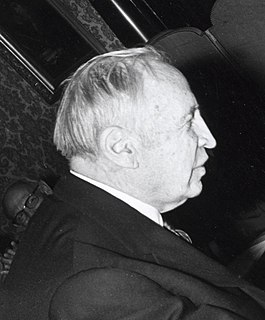
Arnold Johannes Wilhelm Sommerfeld, was a German theoretical physicist who pioneered developments in atomic and quantum physics, and also educated and mentored many students for the new era of theoretical physics. He served as doctoral supervisor for many Nobel Prize winners in physics and chemistry.

Mohammad Abdus Salam was a Pakistani theoretical physicist and a Nobel Prize laureate. He shared the 1979 Nobel Prize in Physics with Sheldon Glashow and Steven Weinberg for his contribution to the electroweak unification theory. He was the first Pakistani and the first from an Islamic country to receive a Nobel Prize in science and the second from an Islamic country to receive any Nobel Prize, after Anwar Sadat of Egypt.

Peter Ware Higgs is a British theoretical physicist, Emeritus Professor in the University of Edinburgh, and Nobel Prize laureate for his work on the mass of subatomic particles.

Max Theodor Felix von Laue was a German physicist who received the Nobel Prize in Physics in 1914 for his discovery of the diffraction of X-rays by crystals.

Sir Edward Victor Appleton was an English physicist, Nobel Prize winner (1947) and pioneer in radiophysics. He studied, and was also employed as a lab technician, at Bradford College from 1909 to 1911.

John Hasbrouck Van Vleck was an American physicist and mathematician. He was co-awarded the Nobel Prize in Physics in 1977, for his contributions to the understanding of the behavior of electronic magnetism in solids.

Michael James Duff FRS, FRSA is a British theoretical physicist and pioneering theorist of supergravity who is the Principal of the Faculty of Physical Sciences and Abdus Salam Chair of Theoretical Physics at Imperial College London.
John Henry Schwarz is an American theoretical physicist. Along with Yoichiro Nambu, Holger Bech Nielsen, Joël Scherk, Gabriele Veneziano, Michael Green, and Leonard Susskind, he is regarded as one of the founders of string theory.
Michael Boris Green is a British physicist and a pioneer of string theory. He is Professor of Theoretical Physics in the School of Physics and Astronomy at Queen Mary University of London, emeritus professor in the Department of Applied Mathematics and Theoretical Physics and a Fellow of Clare Hall, Cambridge. He was Lucasian Professor of Mathematics from 2009 to 2015.
Francis Edwin Close, is a particle physicist who is Emeritus Professor of Physics at the University of Oxford and a Fellow of Exeter College, Oxford.
Wilhelm Lenz was a German physicist, most notable for his invention of the Ising model and for his application of the Laplace–Runge–Lenz vector to the old quantum mechanical treatment of hydrogen-like atoms.

Franz Serafin Exner was an Austrian physicist.

Seifallah Randjbar-Daemi is an Iranian theoretical physicist. He is currently an Emeritus Scientist at the International Centre for Theoretical Physics.
Walter Gordon was a German theoretical physicist.
Faheem Hussain, was a Pakistani theoretical physicist and a professor of physics at the Lahore University of Management Sciences (LUMS). A research scientist in the field of superstring theory at the National Center for Physics, Hussain made contributions to the fields of superstring and string theory. He was the first Pakistani physicist to publish a research paper in the field of superstring theory. A social activist and democratic activist, he authored various scientific research papers in peer-reviewed journals.
Muneer Ahmad Rashid, FPAS, also spelled as Munir Ahmad Rashid, is a Pakistani mathematical physicist and emeritus professor of applied and mathematical physics at the Centre for Advanced Mathematics and Physics of the National University of Sciences and Technology.
Mary Taylor Slow was a British physicist who worked on the theory of radio waves and the application of differential equations to physics. She was the first woman to take up the study of radio as a profession.
Otto Hittmair (1924–2003) was an Austrian theoretical physicist who made contributions to quantum mechanics, superconductivity and unified field theory. From 1987 to 1991 he was President of the Austrian Academy of Sciences.
Hari Keshab Sen, popularly known as H. K. Sen was an Indian Bengali scientist, astrophysicist. He was known for the Sen-Wyller magneto-ionic theory, which is a generalisation of the standard Appleton-Hartree formula for radio wave propagation through a weakly ionized gas in a magnetic field. The Sen-Wyller magneto-ionic theory was discoversd in 1960 by Hari Keshab Sen and A. A. Wyller.
Iain William Stewart is a Canadian-American theoretical nuclear and particle physicist at the Massachusetts Institute of Technology, where he is the Otto and Jane Morningstar Professor of Science and the current Director of the MIT Center for Theoretical Physics (CTP). He is best known for his work on effective field theories and for developing the Soft Collinear Effective Theory (SCET).








